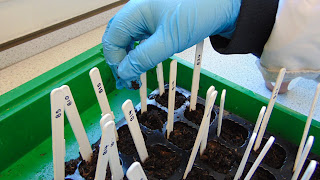Greetings fellow Scientists!
Our Rocket Science experiment is going well. Today Clare and Ellie took the first measurements:
We calculated the percentage of the seeds that have germinated in each tray:
This is the official blog of The Smarties Science Club at Jo Richardson Community School.
Thursday 28 April 2016
Monday 25 April 2016
Mission: Starlight - RSC Global Experiment
Greetings fellow Scientists!
In today's session we took part in the Royal Society of Chemistry Global Experiment 2016 called Mission: Starlight. This year the focus is on UV protection. Watch the clip to find out more:
In today's session we took part in the Royal Society of Chemistry Global Experiment 2016 called Mission: Starlight. This year the focus is on UV protection. Watch the clip to find out more:
The beads used in this experiment change colour when exposed to UV light. Have a look at these "before" and "after" photos:
before after
We completed the following experiments:
What particle size produces the most effective suspension?
Can liquid coating block UV light?
Thursday 21 April 2016
Smarties on Twitter
Greetings fellow Scientists!
The Smarties Science Club is now on Twitter! Follow us @JRCS_Smarties to get all the updates.
The Smarties Science Club is now on Twitter! Follow us @JRCS_Smarties to get all the updates.
Location:
London, UK
Tuesday 19 April 2016
Rocket Science - it's ON!
Greetings fellow Scientistes!
As mentioned yesterday (click here) we are taking part in the Rocket Science Experiment organised by the RHS Campaign for School Gardening.
We started by preparing the trays:
Devika prepared all the labels:
The slots were clearly labelled and all 200 seeds were planted:
Visit SC3 to check the progress of the project:
Follow us on twitter @JRCS_Smarties to get regular updates.
As mentioned yesterday (click here) we are taking part in the Rocket Science Experiment organised by the RHS Campaign for School Gardening.
We started by preparing the trays:
Devika prepared all the labels:
The slots were clearly labelled and all 200 seeds were planted:
Visit SC3 to check the progress of the project:
Follow us on twitter @JRCS_Smarties to get regular updates.
Location:
London, UK
Rocket Science
Greetings fellow Scientists!
The scientists at The Smarties Science Club are preparing to become
space biologists and embark on a voyage of discovery by growing seeds that have
been into space.
In September 2015, 2kg of rocket seeds were flown to the International
Space Station (ISS) on Soyuz 44S where they will spend several months in
microgravity before returning to Earth in March 2016. The seeds have been sent
as part of Rocket Science, an educational project launched by the RHS Campaign
for School Gardening and the UK Space Agency.
JRCS will be one of up to 10,000 schools to receive a packet of 100
seeds from space, which they will grow alongside seeds that haven’t been to
space and measure the differences over seven weeks. The pupils won’t know which
seed packet contains which seeds until all results have been collected by the
RHS Campaign for School Gardening and analysed by professional
biostatisticians.
The out-of-this-world, nationwide science experiment will enable the students
to think more about how we could preserve human life on another planet in the
future, what astronauts need to survive long-term missions in space and the
difficulties surrounding growing fresh food in challenging climates.
Rocket Science is just one educational project from a programme
developed by the UK Space Agency to celebrate British ESA astronaut Tim Peake’s
Principia mission to the ISS and inspire young people to look into careers in STEM
(science, technology, engineering and maths) subjects, including horticulture.
Follow the project on Twitter: @RHSSchools #RocketScience
We received the parcel yesterday and will be sowing the seeds today.
Visit our blog regularly to get all the updates!
Monday 18 April 2016
Water labels analysis
Greeting fellow Scientists!
As a part of the International Co-operation Project with the Volcano Science Club from Gimnazjum no 4 in Stargard, Poland, we completed one of the tasks. The aim was to collect the labels from 3 different water bottles and analyse the mineral content of each of them.
As a part of the International Co-operation Project with the Volcano Science Club from Gimnazjum no 4 in Stargard, Poland, we completed one of the tasks. The aim was to collect the labels from 3 different water bottles and analyse the mineral content of each of them.
After this was done, we started working on presentations which are going to compare selected water brands.
When this task is done, we are going to send the work to our friend from Poland and they are going to send us their findings for comparison.
Location:
London, UK
Monday 11 April 2016
Molecular gastronomy - basic spherification
Greetings fellow Scientists!
Today we attempted molecular gastronomy. We tried basic spherification, here's how it's done:
We started by adding sodium alginate to our chosen liquid:
Then, we used the sieve to strain it:
After that we prepared the calcium chloride bath. After all this was done, the real fun started! Using a syringe, we created tiny spheres:
Quality control by Havilah and Lewis:
Today we attempted molecular gastronomy. We tried basic spherification, here's how it's done:
We started by adding sodium alginate to our chosen liquid:
Then, we used the sieve to strain it:
Quality control by Havilah and Lewis:
And of course tasting:
Location:
London, UK
Subscribe to:
Posts (Atom)

















































